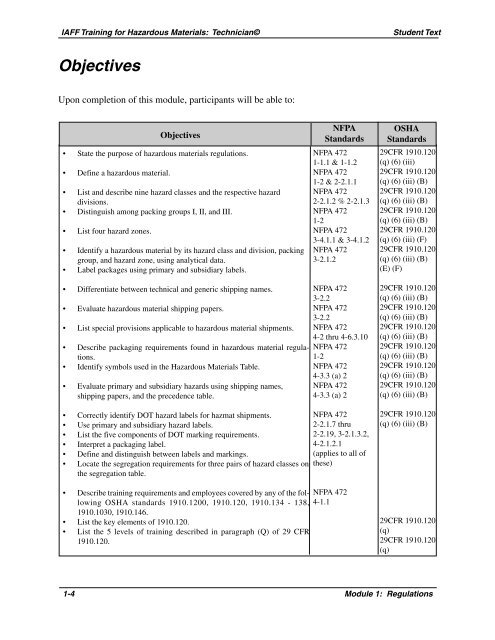Module 1: Regulations - International Association of Fire Fighters
Module 1: Regulations - International Association of Fire Fighters
Module 1: Regulations - International Association of Fire Fighters
You also want an ePaper? Increase the reach of your titles
YUMPU automatically turns print PDFs into web optimized ePapers that Google loves.
IAFF Training for Hazardous Materials: Technician© Student Text<br />
Objectives<br />
Upon completion <strong>of</strong> this module, participants will be able to:<br />
• State the purpose <strong>of</strong> hazardous materials regulations.<br />
• Define a hazardous material.<br />
• List and describe nine hazard classes and the respective hazard<br />
divisions.<br />
• Distinguish among packing groups I, II, and III.<br />
• List four hazard zones.<br />
Objectives<br />
• Identify a hazardous material by its hazard class and division, packing<br />
group, and hazard zone, using analytical data.<br />
• Label packages using primary and subsidiary labels.<br />
NFPA<br />
Standards<br />
NFPA 472<br />
1-1.1 & 1-1.2<br />
NFPA 472<br />
1-2 & 2-2.1.1<br />
NFPA 472<br />
2-2.1.2 % 2-2.1.3<br />
NFPA 472<br />
1-2<br />
NFPA 472<br />
3-4.1.1 & 3-4.1.2<br />
NFPA 472<br />
3-2.1.2<br />
OSHA<br />
Standards<br />
29CFR 1910.120<br />
(q) (6) (iii)<br />
29CFR 1910.120<br />
(q) (6) (iii) (B)<br />
29CFR 1910.120<br />
(q) (6) (iii) (B)<br />
29CFR 1910.120<br />
(q) (6) (iii) (B)<br />
29CFR 1910.120<br />
(q) (6) (iii) (F)<br />
29CFR 1910.120<br />
(q) (6) (iii) (B)<br />
(E) (F)<br />
• Differentiate between technical and generic shipping names.<br />
• Evaluate hazardous material shipping papers.<br />
• List special provisions applicable to hazardous material shipments.<br />
• Describe packaging requirements found in hazardous material regulations.<br />
• Identify symbols used in the Hazardous Materials Table.<br />
• Evaluate primary and subsidiary hazards using shipping names,<br />
shipping papers, and the precedence table.<br />
• Correctly identify DOT hazard labels for hazmat shipments.<br />
• Use primary and subsidiary hazard labels.<br />
• List the five components <strong>of</strong> DOT marking requirements.<br />
• Interpret a packaging label.<br />
• Define and distinguish between labels and markings.<br />
• Locate the segregation requirements for three pairs <strong>of</strong> hazard classes on<br />
the segregation table.<br />
• Describe training requirements and employees covered by any <strong>of</strong> the following<br />
OSHA standards 1910.1200, 1910.120, 1910.134 - 138,<br />
1910.1030, 1910.146.<br />
• List the key elements <strong>of</strong> 1910.120.<br />
• List the 5 levels <strong>of</strong> training described in paragraph (Q) <strong>of</strong> 29 CFR<br />
1910.120.<br />
NFPA 472<br />
3-2.2<br />
NFPA 472<br />
3-2.2<br />
NFPA 472<br />
4-2 thru 4-6.3.10<br />
NFPA 472<br />
1-2<br />
NFPA 472<br />
4-3.3 (a) 2<br />
NFPA 472<br />
4-3.3 (a) 2<br />
NFPA 472<br />
2-2.1.7 thru<br />
2-2.19, 3-2.1.3.2,<br />
4-2.1.2.1<br />
(applies to all <strong>of</strong><br />
these)<br />
NFPA 472<br />
4-1.1<br />
29CFR 1910.120<br />
(q) (6) (iii) (B)<br />
29CFR 1910.120<br />
(q) (6) (iii) (B)<br />
29CFR 1910.120<br />
(q) (6) (iii) (B)<br />
29CFR 1910.120<br />
(q) (6) (iii) (B)<br />
29CFR 1910.120<br />
(q) (6) (iii) (B)<br />
29CFR 1910.120<br />
(q) (6) (iii) (B)<br />
29CFR 1910.120<br />
(q) (6) (iii) (B)<br />
29CFR 1910.120<br />
(q)<br />
29CFR 1910.120<br />
(q)<br />
1-4 <strong>Module</strong> 1: <strong>Regulations</strong>
















